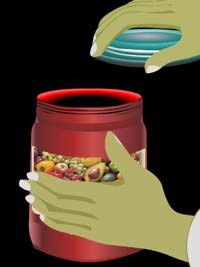In this unit I’ve learned lots of things about mechanisms and machines
that before I didn’t know. First of all, now I can recognize the six basic simple machines,
which are the lever, the screw, the pulley, the wheel and axle and the wedge.
·
The
lever: it helps us lift things with less effort. A lever can
be described as a long rigid body with a fulcrum along its length. They can be
classified in three groups depending where the fulcrum, load and force is
applied.
o
1st class: the fulcrum is between the load
and the effort.
o
2nd class: the load is between the fulcrum
and the effort.
o
3rd class: the effort is between the fulcrum
and the load.
§ One
example could be the bottle opener.
·
The
screw: it consists of a long and thin metal shaft with threads
spiraling along its length. It also has a turning head with a groove where a
screwdriver can be used to rotate the screw. It converts rotational motion into
linear motion.
o
A really common example could be the bottle lid that we
use to close the bottle.
·
Inclined
plane: when we reduce the effort to take something up by
increasing the distance. For example if we have to lift somebody who is on a
wheelchair we will use and inclined plane to reduce the effort but we will
increase the distance.
o
A slope would be an example of our daily life, due that
every day when we go to the school there are a lot.
·
Pulley: a
basic pulley comprises of a wheel on a fixed axle, with a groove along the
edges to guide a rope.(Foto). It is used to lift thins easily such as heavy
boxes. When you put two or more wheels together, and run a rope around them you
make less effort and you have created a great lifting machine.
o
A daily life example could be a water well.
·
Wheel
and axel: when we have to move really heavy objects, we have to
use a big amount of force to push it. This is due to friction (force resisting
the motion of the object on the ground) and the gravitational force (force that
pulls the object to the ground). In this simple machine, a wheel is locked to a
central axle and they rotate each other when a force is applied on either of
them.
o
A daily life
example would be part of the wheelbarrow, that workers use it to lift debris.
·
Wedge:
the wedge is the active twin of the inclined plan. But unlike the inclined
plane which is stationary, a wedge does useful work by moving. For a wedge, the
effort is applied to the vertical edge of the wedge. We can use it to lift
heavy loads or to hold an object in place and avoid it from moving.
o
Examples of wedges that we use every day could be a
knife, saw…
Types of motion
· Linear motion: moving one way in a straight line. Example: direction of a train.
· Reciprocating motion: moving forwards and backwards in a straight line. Example: the follower of a cam.
· Oscillating motion: moving forwards and backwards in an arc. Example: swing
A mechanism is a device which takes an input motion and force, and outputs a
different motion and force. The mechanisms are used to simplify a job. The
mechanisms most commonly used in mechanical systems are levers, linkages,
cams, gears, and and pulleys.
·
Levers:
is a long rigid body with a fulcrum along its length. They
can be classified in three groups depending where the fulcrum, load and force
is applied.
·
Linkages: Linkages are mechanisms which allow force or
motion to be directed where it is needed.
o Linkages can be used to change:
§ The direction of motion
§ The type of motion
§ The size of a force
o There are four
different types:
§ Reverse-motion linkage
§ Parallel-motion linkage
§ Bell-crank linkage
§ Treadle linkage
·
Cams: it is a shaped piece of metal or plastic
fixed to a rotating shaft. A cam mechanism has three parts: cam, slide and
follower. The cam shaft rotates continually, turning the cam. The follower is a
rod that rests on the edge of the turning cam. The follower is free to move up
and down.
o Types:
§ Pear-shaped cam
§ Eccentric cam
§ Drop cam
·
Gears: it consists of toothed wheels fixed to
shafts. The teeth interlock with each other, and as the first shaft (the driver
shaft) rotates, the motion is transmitted to the second or driven shaft. The
motion output at the driven shaft will be different from the motion input at
the driver shaft.
o Types:
§ Rack and pinion
§ Worm gear
§ Bevel gear
§ Compound gear train
·
Pulleys: they
are used to change the speed, direction of rotation, or turning force or torque. A pulley system consists
of two pulley wheels each
on a shaft, connected by a belt.
This transmits rotary motion and force from the input, or driver shaft, to the
output, or driven shaft.
Bibliography:





























No hay comentarios:
Publicar un comentario